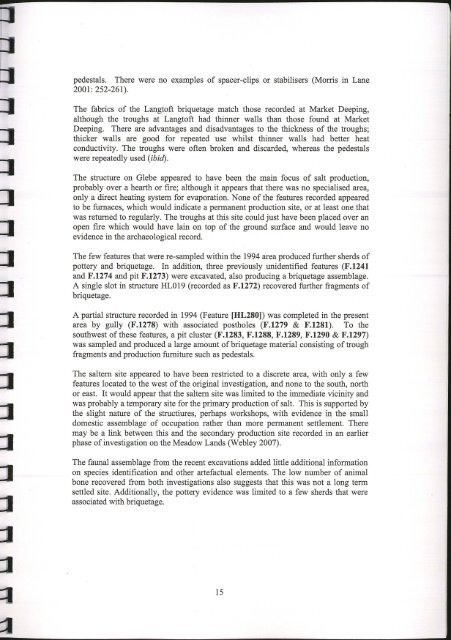Further Excavations At Langtoft. Lincolnshire www - Archaeology ...
Further Excavations At Langtoft. Lincolnshire www - Archaeology ...
Further Excavations At Langtoft. Lincolnshire www - Archaeology ...
Create successful ePaper yourself
Turn your PDF publications into a flip-book with our unique Google optimized e-Paper software.
pedestals. There were no examples of spacer-clips or stabilisers (Morris in Lane<br />
2001:252-261).<br />
The fabrics of the <strong>Langtoft</strong> briquetage match those recorded at Market Deeping,<br />
although the troughs at <strong>Langtoft</strong> had thinner walls than those found at Market<br />
Deeping. There are advantages and disadvantages to the thickness of the troughs;<br />
thicker walls are good for repeated use whilst thinner walls had better heat<br />
conductivity. The troughs were often broken and discarded, whereas the pedestals<br />
were repeatedly used {ibid).<br />
The structure on Glebe appeared to have been the main focus of salt production,<br />
probably over a hearth or fire; although it appears that there was no specialised area,<br />
only a direct heating system for evaporation. None of the features recorded appeared<br />
to be furnaces, which would indicate a permanent production site, or at least one that<br />
was returned to regularly. The troughs at this site could just have been placed over an<br />
open fire which would have lain on top of the ground surface and would leave no<br />
evidence in the archaeological record.<br />
The few features that were re-sampled within the 1994 area produced further sherds of<br />
pottery and briquetage. In addition, three previously unidentified features (F.1241<br />
and F.1274 and pit F.1273) were excavated, also producing a briquetage assemblage.<br />
A single slot in structure HL019 (recorded as F.1272) recovered further fragments of<br />
briquetage.<br />
A partial structure recorded in 1994 (Feature [HL280]) was completed in the present<br />
area by gully (F.1278) with associated postholes (F.1279 & F.1281). To the<br />
southwest of these features, a pit cluster (F.1283, F.1288, F.1289, F.1290 & F.1297)<br />
was sampled and produced a large amount of briquetage material consisting of trough<br />
fragments and production furniture such as pedestals.<br />
The saltern site appeared to have been restricted to a discrete area, with only a few<br />
features located to the west of the original investigation, and none to the south, north<br />
or east. It would appear that the saltern site was limited to the immediate vicinity and<br />
was probably a temporary site for the primary production of salt. This is supported by<br />
the slight nature of the structiures, perhaps workshops, with evidence in the small<br />
domestic assemblage of occupation rather than more permanent settlement. There<br />
may be a link between this and the secondary production site recorded in an earlier<br />
phase of investigation on the Meadow Lands (Webley 2007).<br />
The faunal assemblage from the recent excavations added little additional information<br />
on species identification and other artefactual elements. The low number of animal<br />
bone recovered from both investigations also suggests that this was not a long term<br />
settled site. Additionally, the pottery evidence was limited to a few sherds that were<br />
associated with briquetage.<br />
15

















